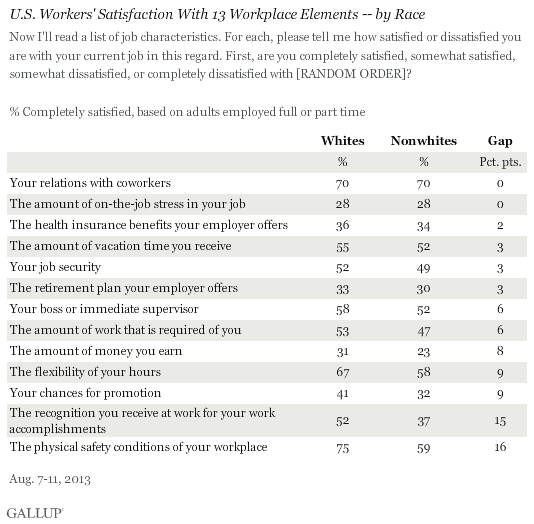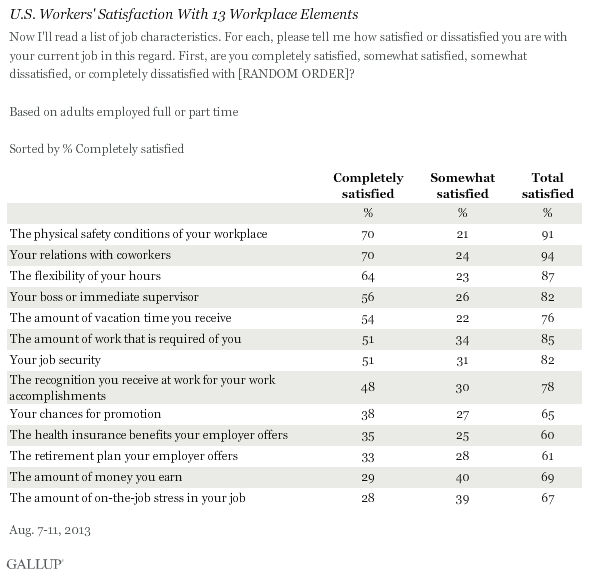PRINCETON, NJ -- Women are as likely as men to be highly satisfied with various aspects of their jobs, with pay the lone exception. Of the 13 job characteristics measured, pay is the only one associated with a significant gender gap: 32% of men and 24% of women say they are completely satisfied with their pay. However, neither group is particularly enthused on this dimension.

Women and men have similar views of the other 12 job aspects. Besides pay, both genders are least satisfied with the amount of on-the-job stress they have at work. They are most satisfied with the physical safety of their workplace and their relationships with coworkers.
In terms of race, white and nonwhite U.S. workers also have a lot more in common than not when it comes to how they perceive their own jobs. Of the 13 workplace characteristics Gallup asked about in this year's Work and Education poll, whites and nonwhites report statistically similar levels of satisfaction with all but two.
Whites are significantly more likely than nonwhites to be highly satisfied with the physical safety conditions where they work (75% vs. 59%) and with the recognition they receive at work for their accomplishments (52% vs. 37%).

The Aug. 7-11 survey is based on interviews with 2,059 national adults, aged 18 and older, of which 1,039 are employed full or part time. The sample of workers includes 809 non-Hispanic whites and 206 nonwhites, a category that includes Hispanics in addition to blacks and other racial minorities.
White and nonwhite U.S. workers express highly similar views about their relations with coworkers -- 70% of both groups say they are "completely satisfied" with this -- as well as with the amount of on-the-job stress they have, their health insurance benefits, vacation time, job security, and retirement plan. Whites are a bit more likely than nonwhites to say they are completely satisfied with their boss/supervisor, the amount of work required of them, what they earn, the flexibility of their hours, and their chances for promotion. However the six- to nine-percentage-point gaps seen in these views are not statistically significant, given the number of interviews conducted with each group.
Gallup finds relatively slight differences in the broad types of employment whites and nonwhites say they perform. Thirty-eight percent of whites and 36% of nonwhites indicate they have a professional or executive position; 41% of whites and 37% of nonwhites have another type of white-collar job; and 20% of whites vs. 28% of nonwhites have a blue-collar job. Thus, it is not immediately clear why the two racial categories of workers would have differing perspectives on either job safety or personal recognition.
Professionals and Executives Cite Better Benefits, Safety; Little Else
Adults working in professional careers or with executive-level positions are more likely than blue-collar workers to say they are completely satisfied with the amount of vacation time they get (63% vs. 44%), and with the health insurance and retirement plans their employer offers. But notably, they are no more likely to be satisfied with their pay, their boss, their job security, or even the workplace recognition they get for their accomplishments.
Not surprisingly, professionals/executives and other white-collar workers express higher satisfaction with physical safety conditions where they work than do blue-collar workers.

The overall rank order of job characteristics according to worker satisfaction has been fairly stable across the 15 years Gallup has tracked this. As is typical, U.S. workers show their highest satisfaction with physical safety conditions and coworker relations, and the least satisfaction with stress and pay.

Bottom Line
Employees' perceptions about various aspects of their jobs may be relative, driven partly by positive or negative expectations they have had; however, on the face of it, U.S. workers of differing genders and races have similar feelings about how they are treated, the benefits they are offered, and the opportunities available to them.
That is not to say that workers are broadly satisfied with all of these things. The percentage completely satisfied ranges from above 50% with respect to one's boss, flexibility of hours, and workload, among other factors, to below 30% for pay and stress. Yet these attitudes largely transcend race and gender. Key exceptions include nonwhites' lower satisfaction with the recognition they feel they receive at work for their accomplishments and women's lower satisfaction with their pay.
The more significant factor in higher or lower satisfaction on some items is type of job, with professionals and executives, as well as other white-collar workers, generally feeling more positive about certain aspects of their jobs, like employee benefits and safety, than do blue-collar workers. But here again, differences are the exception, not the rule.
Survey Methods
Results for this Gallup poll are based on telephone interviews conducted Aug. 7-11, 2013, with a random sample of 2,059 adults, aged 18 and older, living in all 50 U.S. states and the District of Columbia.
For results based on the sample of 1,039 adults who are employed full- or part-time, the maximum margin of sampling error is ±4 percentage points.
Interviews are conducted with respondents on landline telephones and cellular phones, with interviews conducted in Spanish for respondents who are primarily Spanish-speaking. Each sample of national adults includes a minimum quota of 50% cellphone respondents and 50% landline respondents, with additional minimum quotas by region. Landline and cell telephone numbers are selected using random-digit-dial methods. Landline respondents are chosen at random within each household on the basis of which member had the most recent birthday.
Samples are weighted to correct for unequal selection probability, nonresponse, and double coverage of landline and cell users in the two sampling frames. They are also weighted to match the national demographics of gender, age, race, Hispanic ethnicity, education, region, population density, and phone status (cellphone only/landline only/both, and cellphone mostly). Demographic weighting targets are based on the March 2012 Current Population Survey figures for the aged 18 and older U.S. population. Phone status targets are based on the July-December 2011 National Health Interview Survey. Population density targets are based on the 2010 census. All reported margins of sampling error include the computed design effects for weighting.
In addition to sampling error, question wording and practical difficulties in conducting surveys can introduce error or bias into the findings of public opinion polls.
View methodology, full question results, and trend data.
For more details on Gallup's polling methodology, visit www.gallup.com.
